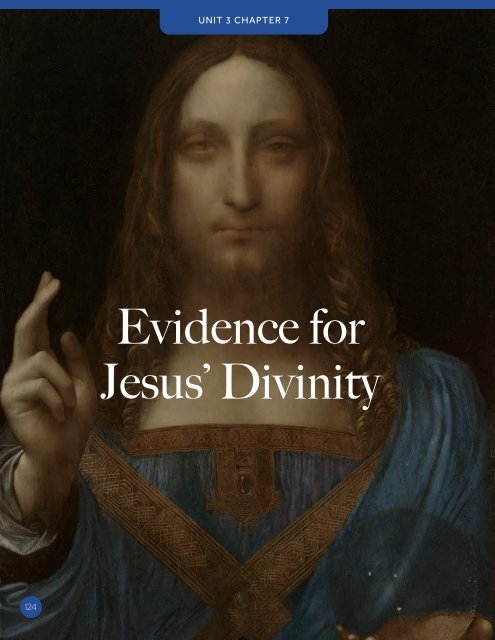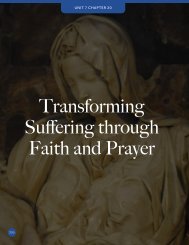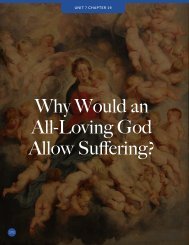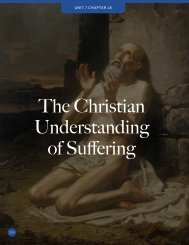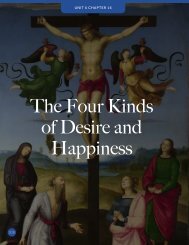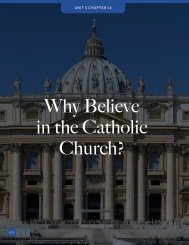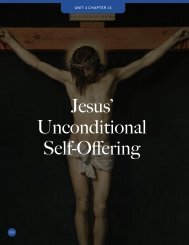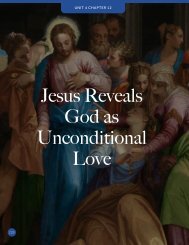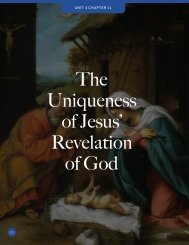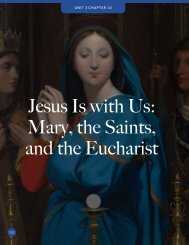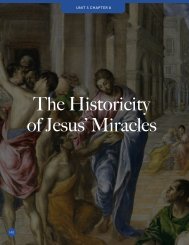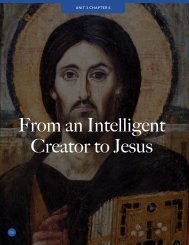CFS-WB-CH07
Create successful ePaper yourself
Turn your PDF publications into a flip-book with our unique Google optimized e-Paper software.
UNIT 3 CHAPTER 7<br />
Evidence for<br />
Jesus’ Divinity<br />
124
Chapter 7 Overview<br />
In the last chapter you reflected on how you would answer six questions with significant implications for your<br />
life of faith and your relationship with Jesus Christ, who is Emmanuel — God with us in the flesh. In this chapter,<br />
we will turn our attention to the bountiful evidence that supports this claim. We will begin with evidence<br />
from outside the Bible, and then turn to the evidence we can find from the Gospels and the rest of the New<br />
Testament.<br />
In this chapter you will learn that …<br />
■ A preponderance of evidence exists both in Scripture, specifically the Gospels, and in non-scriptural sources that<br />
support Jesus’ claim to be divine.<br />
■ The preaching of the Apostolic Church is remarkably consistent in its central claims about Jesus contained in the<br />
kerygmas.<br />
■ The New Testament accounts of Jesus’ life are trustworthy and persuasive.<br />
■ Most scholars conclude from the evidence that something happened to Jesus’ body after His death that is<br />
attributable to a supernatural cause.<br />
■ Accounts of near-death experiences correlate with certain details of Jesus’ Resurrection.<br />
Bible Basics<br />
For I delivered to you as of first importance<br />
what I also received, that Christ died for our<br />
sins in accordance with the scriptures, that he<br />
was buried, that he was raised on the third day<br />
in accordance with the scriptures, and that he<br />
appeared to Cephas, then to the twelve. Then<br />
he appeared to more than five hundred brethren<br />
at one time most of whom are still alive,<br />
though some have fallen asleep. Then he appeared<br />
to James, then to all the apostles. Last<br />
of all, as to one untimely born, he appeared<br />
also to me.<br />
—1 Corinthians 15:3–8<br />
[I]f Christ has not been raised, then our<br />
preaching is in vain and your faith is in vain. We<br />
are even found to be misrepresenting God,<br />
because we testified of God that he raised<br />
Christ ... If Christ has not been raised, your faith<br />
is futile and you are still in your sins.<br />
— 1 Corinthians 15:14–17<br />
Connections to the Catechism<br />
■ CCC 445<br />
■ CCC 464–478<br />
■ CCC 638–655<br />
© Sophia Institute for Teachers<br />
125
Chapter 7<br />
Follow the Evidence<br />
Thus far in this unit we have considered six questions whose answers<br />
have significant implications not only for our own lives of faith, but also<br />
the way we interact with the central and most foundational truth of our<br />
Faith: that Jesus Christ is the Son of God become man — Emmanuel<br />
(“God with us”). Now we turn our attention to the preponderance of<br />
evidence that exists supporting this claim. Since evidence from the<br />
Bible may be least likely to convince skeptics of Christianity, we will begin<br />
this chapter with what we know about Jesus from outside the New<br />
Testament.<br />
Historical Works<br />
Outside of the Gospels, there are three notable sources from the<br />
period — sources that were not interested in Christ as the Messiah, and<br />
even hostile to Him, but which mention Him in their own historical works.<br />
The Roman historian, Cornelius Tacitus<br />
In his Annals (ca. AD 105–120), while recounting how Nero blamed the<br />
Christians for the burning of Rome, Tacitus provides a non-Christian<br />
historical reference to Jesus. It states that Christus was executed by<br />
crucifixion at the hands of Pontius Pilate during the reign of the Roman<br />
Emperor Tiberius.<br />
The Jewish historian, Flavius Josephus<br />
Flavius Josephus (a Jewish historian writing a history of the Jewish<br />
people for a Roman audience in approximately AD 93) provides the<br />
most impressive and detailed evidence for the historical Jesus outside<br />
Christian scripture. Josephus’ Antiquities of the Jewish People cites<br />
Jesus’ Crucifixion under Pontius Pilate, and refers to Jesus as wise,<br />
having authority, a teacher and a wonder-worker (miracle-worker). This<br />
reference to miracles is rare in Josephus’ history. John the Baptist, for<br />
example, receives a long description but without any mention of miracles.<br />
The fact that a Jewish historian writing for the Romans would<br />
mention not only Jesus’ execution by crucifixion, but also the positive<br />
attributes of His wisdom, authority, teaching, and miracle-working indicates<br />
how well-known Jesus’ reputation was for these attributes.<br />
126 Apologetics I: The Catholic Faith and Science<br />
© Magis Center
Jewish historian Flavius<br />
Josephus described Jesus’<br />
Crucifixion under Pontius<br />
Pilate and Jesus as a wise<br />
teacher and wonder-worker<br />
in his work Antiquities of the<br />
Jewish People.<br />
Aa<br />
VOCABULARY<br />
Babylonian Talmud:<br />
Compilation of Jewish oral law<br />
and other rabbinical material<br />
completed around AD 400.<br />
Portrait of Flavius Josephus, by Jan Caspar Philipsnaar.<br />
The Babylonian Talmud<br />
This Jewish source compiled Jewish oral law and other rabbinical material<br />
from prior centuries, was mostly written between AD 50–300 and<br />
completed around AD 400. It contains several references to Jesus, including<br />
His Crucifixion and His reputation for supernatural power. The<br />
Babylonian Talmud is especially notable as evidence since the passages<br />
indicate a rabbinical hostility toward Jesus, and their negative tone<br />
precludes any suspicion of Christian influence.<br />
In sum, Tacitus speaks to the historicity of Jesus’ trial and<br />
Crucifixion — naming both Pontius Pilate as procurator and Tiberius<br />
as Caesar. Josephus also speaks to Jesus’ Crucifixion under Pontius<br />
Pilate, explicitly mentioning Jesus as wise, authoritative, and as teacher<br />
and miracle worker. The Babylonian Talmud affirms Jesus’ Crucifixion<br />
and miracle working.<br />
© Sophia Institute for Teachers<br />
Unit 3, Chapter 7: Evidence for Jesus’ Divinity<br />
127
St. Paul and the Apostles<br />
faced alienation, persecution,<br />
torture, and execution for<br />
claiming Jesus was divine.<br />
Kerygmas: Brief Christian<br />
texts that express simple<br />
credal teachings. These were<br />
the first proclamations of the<br />
Early Church, written within a<br />
decade of Jesus’ Death and<br />
Resurrection, and preserved in<br />
the New Testament within the<br />
Acts of the Apostles and the<br />
Letters of St. Paul.<br />
St. Paul Preaching in Athens, by Raphael.<br />
The Preaching of the Apostolic Church<br />
The earliest information we have about Jesus is found in the<br />
kerygmas — brief texts that proclaim in a relatively simple way the basic<br />
core teachings of the Gospel message (kerygma is Greek for “proclamation”).<br />
These were the first proclamations of the Early Church, written<br />
within a mere decade of Jesus’ Death and Resurrection. They have<br />
been preserved in the New Testament within the Acts of the Apostles<br />
and the Letters of St. Paul. (See: Acts 2:14–39; 3:13–26; 4:10–12; 5:30–<br />
32; 10:36–43; 13:17–41; 1 Thessalonians 1:10; 1 Corinthians 15:1–7; and<br />
Romans 8:34.)<br />
These proclamations have eight repeated themes:<br />
1. Jesus was a descendant of David.<br />
2. Jesus was predicted by the Prophets.<br />
3. Jesus worked miracles.<br />
4. Jesus was crucified and buried for our sins (in all major kerygmas).<br />
5. Jesus rose in glory (in all major kerygmas).<br />
6. Jesus gave His disciples the Holy Spirit.<br />
7. Jesus is now exalted in God.<br />
8. Jesus is therefore, Messiah and Lord.<br />
128 Apologetics I: The Catholic Faith and Science<br />
© Magis Center
Since these themes form the foundation of Christian creeds today,<br />
they might strike us as routine and familiar. But these are radical claims<br />
that Christians were making about Jesus right at the beginning. Calling<br />
a man the Lord (the term in New Testament Greek — ho Kurios — is a<br />
translation of the Divine name Yahweh) would have been blasphemous<br />
in the eyes of other Jews, and calling a crucified man God would have<br />
been repulsive to virtually everyone. Furthermore, the early Christians<br />
suffered terribly for their claim of Jesus’ divinity — they lost their social<br />
and financial status, were religiously ostracized and ultimately expelled<br />
from the synagogue, and were persecuted to the point of death. Why<br />
would anyone risk alienating their audience, getting expelled from the<br />
synagogues, losing social status, and facing persecution and death for<br />
claiming Jesus was divine if they were not sure it was true? All of this<br />
suffering could have been avoided by simply calling Jesus a holy man,<br />
or a martyr-prophet who lost His life for the truth. Something must have<br />
impressed the early Christians to make such specific, radical claims in<br />
the face of such strong disincentives. Three possible reasons why the<br />
Church would have believed in Jesus’ divinity so strongly in the face of<br />
such sacrifices would seem to be His Resurrection and glory, His gift of<br />
the Holy Spirit, and the miracles He worked by His own authority during<br />
His ministry. We will first consider in this chapter the evidence for Jesus’<br />
Resurrection and glory. In Chapter 8 we will take a look at the evidence<br />
for Jesus’ miracles and the sending of the Holy Spirit.<br />
Gnostic Gospels: Ancient<br />
books about the life of Christ<br />
that are infused with false<br />
theology that reflects the<br />
Gnostic heresy rampant at the<br />
time. Two are falsely attributed<br />
to St. Thomas the Apostle and<br />
St. Mary Magdalene.<br />
The Evidence of the Heart<br />
Before we proceed, we must first reflect on the fact that, even though<br />
we are looking at a lot of hard evidence in this unit, anytime we are genuinely<br />
being persuaded of something — rather than just scoring points<br />
in an argument — there are usually additional factors besides the evidence<br />
itself. One of these factors is the trustworthiness and general<br />
feel we get of the person giving the evidence. In the case of the New<br />
Testament, there are several striking patterns that can inspire confidence<br />
in its authors:<br />
1. Restraint: Miracles are reported in simple factual prose, like<br />
a news report, without the dramatic embellishment we find<br />
in any other ancient story of miracles (such as the so-called<br />
Gnostic Gospels).<br />
2. Initital Doubt: All three Gospel accounts of Jesus’ risen<br />
appearance to the Apostles report the initial doubts of the<br />
© Sophia Institute for Teachers<br />
Unit 3, Chapter 7: Evidence for Jesus’ Divinity<br />
129
Resurrected Jesus Christ with Thomas the Apostle, by Sebastiano Santi.<br />
All the Gospels show the<br />
Apostles as initially doubtful<br />
that Jesus had risen from the<br />
dead.<br />
Apostles, a notably honest admission for an account intending to<br />
inspire belief.<br />
3. Humility: Other unflattering details like the insults the religious<br />
authorities leveled at Jesus or the failings and weaknesses of the<br />
Apostles (e.g. Peter’s betrayal) are also included, indicating that<br />
reporting the whole truth was more important than making the<br />
early Church leaders look good.<br />
4. Challenging tone: The restrained reporting, honest inclusion<br />
of unpleasant details, and refusal to explain away challenging<br />
teachings all convey a tone of authors who are convinced of the<br />
truth of what they are reporting but who are not trying to soften<br />
the difficulty of that truth to win people over with a flattering<br />
presentation. There is a bracing earnestness in their writing.<br />
5. Inspiring appeal: Paradoxically, laying out the mission of the<br />
Gospel without trying to soften it or downplay its challenges can<br />
be inspiring, inviting us to aspire to its high calling.<br />
130 Apologetics I: The Catholic Faith and Science<br />
© Magis Center
Jesus’ Resurrection in Glory<br />
While belief in Jesus as Emmanuel (“God with us”) requires a movement<br />
of the heart to recognize our need for love and to be open to receiving<br />
that love, it also requires evidence for the mind that Jesus is divine.<br />
It is for this reason that Jesus’ Resurrection, as a demonstration of his<br />
divine power, is so central to Christianity. St. Paul even remarks that if<br />
Jesus did not rise from the dead, Christians are essentially wasting their<br />
time (1 Corinthians 15). Is there any historical way of verifying whether<br />
the Resurrection happened? The answer to this question is undeniably<br />
yes. Let us now consider the evidence.<br />
Recent Scholarship on the Resurrection<br />
A 2005 survey of exegetes (scholars who analyze the Scriptures) by<br />
Gary Habermas indicates that most agree the early disciples at least<br />
had experiences they perceived as the Risen Christ. A few exegetes<br />
propose natural causes for these experiences (e.g. subjective visions<br />
caused by religious intoxication and enthusiasm). But most seem to<br />
conclude that there was a supernatural cause — that something happened<br />
to Jesus after His Death. The consensus is that Jesus’ body was<br />
transformed; in other words, Jesus did not just appear to the Apostles<br />
as a vision or ghost (a luminous appearance) but fully came back to life<br />
as Himself, with a risen and transformed body (a transformed corporeal<br />
appearance). What evidence has led them to this consensus?<br />
There exist four main areas of evidence:<br />
1. The Gospel accounts of Jesus’ risen appearances to the<br />
Apostles;<br />
2. St. Paul’s testimony to the Resurrection of Jesus;<br />
3. N.T. Wright’s historical analysis of the Resurrection; and<br />
4. The empty tomb.<br />
1. The Gospel Accounts of Jesus’ Risen Appearances to the<br />
Apostles<br />
The Gospel accounts of Jesus’s risen appearances to the Apostles<br />
share many common elements, and one of the most telling of these is<br />
that the Apostles were not expecting what they saw. The general pattern<br />
of the Resurrection narratives is as follows: Jesus’ appearance as a<br />
spiritually and gloriously transformed body, the Apostles’ initial doubts<br />
about this being Jesus, and Jesus’ proof that it is really He.<br />
All the Gospels show the Apostles as initially doubtful of the<br />
Resurrection. They are so overwhelmed by His transformation that<br />
© Sophia Institute for Teachers<br />
Unit 3, Chapter 7: Evidence for Jesus’ Divinity<br />
131
Soma Pneumatikon: Phrase<br />
coined by St. Paul to describe<br />
Christ’s glorified body,<br />
meaning literally “spiritual<br />
body.”<br />
they seem to think they are witnessing a divine vision — not the Jesus<br />
they had worked with during His ministry. Jesus had to reassure them<br />
that — however wondrously transformed — it was really He and really<br />
His actual body. Far from something the Apostles were expecting, let<br />
alone planning, this transformed Christ that appeared to them was so<br />
radically unfamiliar that St. Paul would have to coin a new phrase to describe<br />
it: a Soma Pneumatikon or “Spiritual Body” (1 Corinthians 15:44).<br />
As we continue, we will see just how radical the consequences were for<br />
Christianity in receiving and adopting this new concept.<br />
2. St. Paul’s Testimony to the Resurrection of Jesus<br />
One of the earliest kerygmas is found in 1 Corinthians 15:3–8. It contains<br />
a list of the witnesses to the Resurrection:<br />
For I delivered to you as of first importance what I<br />
also received, that Christ died for our sins in accordance<br />
with the scriptures, that he was buried, that<br />
he was raised on the third day in accordance with the<br />
scriptures, and that he appeared to Cephas, then<br />
to the twelve. Then he appeared to more than five<br />
hundred brethren at one time most of whom are still<br />
alive, though some have fallen asleep. Then he appeared<br />
to James, then to all the apostles. Last of all,<br />
as to one untimely born, he appeared also to me.<br />
Paul seems to be offering this list with an eye to its value as legal<br />
evidence. He mentions that, of the more than five hundred people who<br />
witnessed the Risen Christ, most “are still alive,” implying that his audience<br />
could have still consulted them to corroborate the story. The list<br />
also does not include the women at the tomb — the earliest witnesses<br />
mentioned in the Gospel narratives — as Jewish law of the time would<br />
not have held their witness legally admissible.<br />
Having offered the evidence of these witnesses to the Resurrected<br />
Christ, Paul probes the value of their evidence by laying out a dilemma<br />
in 1 Corinthians 15:14-19: either the witnesses believed in God, or they<br />
did not believe in God. In either case, Paul argues, they had everything<br />
to lose and nothing to gain by falsely claiming to have witnessed the<br />
Resurrection. For a believer to publicly lie that he had witnessed the<br />
Resurrected Christ, he would have put his own salvation in jeopardy<br />
by bearing false witness that undermined and caused apostasy to the<br />
Jewish faith. As Paul said in 1 Corinthians 15:14–19:<br />
[I]f Christ has not been raised, then our preaching<br />
is in vain and your faith is in vain. We are even<br />
132 Apologetics I: The Catholic Faith and Science<br />
© Magis Center
The Risen Christ appeared<br />
radically different to the<br />
Apostles.<br />
Apostasy: The abandonment<br />
or renunciation of one’s<br />
religious faith.<br />
The Ascension, by Benjamin West,<br />
found to be misrepresenting God, because we testified<br />
of God that he raised Christ ... If Christ has<br />
not been raised, your faith is futile and you are still<br />
in your sins.... If for this life only we have hoped in<br />
Christ, we are of all men most to be pitied.<br />
For one who believed in God, lying about the Resurrection represented<br />
the worst possible crime in the eyes of St. Paul. The witnesses<br />
of the Risen Christ, if they were believers, had everything to lose<br />
and nothing to gain by publicly lying about the Resurrection (causing<br />
apostasy), for they were jeopardizing their eternal salvation.<br />
Those who did not believe in God would also have had to make great<br />
sacrifices to preach the Resurrection, which would have made lying<br />
© Sophia Institute for Teachers<br />
Unit 3, Chapter 7: Evidence for Jesus’ Divinity<br />
133
The unprecedented growth<br />
of the early Church gives<br />
evidence not only of the<br />
power of the Holy Spirit in the<br />
ministry of the Apostles, but<br />
also of the Resurrection of<br />
Jesus.<br />
about it senseless. Such a lie would have brought needless suffering<br />
onto oneself. The Resurrection doctrine set the early Christians at odds<br />
with the Jewish tradition they lived in, causing them to be expelled from<br />
their synagogues and ostracized by their communities. It quickly led to<br />
hounding by the Roman authorities as well. Ultimately, it meant active<br />
persecution, torture, and death. It would have been a huge leap of logic<br />
for an unbeliever to willingly associate himself with such persecution<br />
and danger to his own life for a lie he himself did not even believe.<br />
Indeed, Paul himself suffered repeatedly from these threats and<br />
would even die for the Faith. If the Resurrection were a lie, all that suffering<br />
would have been for nothing. As he himself indicated — “If the<br />
dead are not raised, ‘Let us eat and drink, for tomorrow we die’” (1<br />
Corinthians 15:32). Paul uses this dilemma to show (in a legal fashion)<br />
that he and the other witnesses — believers and unbelievers alike — had<br />
everything to lose and nothing to gain by bearing false witness to the<br />
Resurrection of Christ. Their testimony is more reliable since it goes<br />
against their own self-interest.<br />
Constantine’s Conversion, by Peter Paul Rubens<br />
134 Apologetics I: The Catholic Faith and Science<br />
© Magis Center
3. N.T. Wright’s Historical Analysis of the Resurrection<br />
N.T. Wright, a contemporary Anglican New Testament scholar and<br />
Pauline theologian, offers two arguments for the historicity of Jesus’<br />
Resurrection: the remarkable success of Christian messianism and the<br />
Christian mutations of Second Temple Judaism. These two aspects of<br />
the early Church are difficult to account for without the Resurrection.<br />
Messianic Movements:<br />
Groups which formed around<br />
leaders who claimed to be<br />
God’s promised Messiah, and<br />
which inevitably died out after<br />
the leader’s death.<br />
The Remarkable Success of Christian Messianism<br />
The first historical anomaly central to N.T. Wright’s argument is that<br />
there were many messianic movements in the time of Christ, each<br />
separate and distinct from that of Jesus and His followers. Wright lists<br />
several of these: “Judas the Galilean, Simon, Athronges, Eleazar ben<br />
Deinaus and Alexander, Menahem, Simon bar Giora, and bar-Kochba.”<br />
In every case, a charismatic leader attracted an enthusiastic following,<br />
the leader died (usually at the hands of the authorities), his followers<br />
scattered, and the messianic movement soon died. One example of<br />
this pattern is even found in the Gospels with John the Baptist.<br />
Christianity is the one dramatic exception to this pattern. After the<br />
public humiliation and execution of their leader, the disciples did not<br />
fade away. Instead, they began preaching throughout the surrounding<br />
countries that their crucified leader is in fact the Messiah, has succeeded<br />
in fulfilling the ancient prophecies, rose from the dead, and is divine.<br />
Even more shockingly, their messianic movement grew exponentially.<br />
In a few generations, Christianity became the dominant religion of the<br />
Roman Empire. Where did this momentum come from? What inspired<br />
the Apostles with such conviction?<br />
Wright believes that the Apostles would have had no credibility with<br />
this message among the Jewish or Gentile people were it not for two<br />
extraordinary occurrences — (1) the Apostles’ ability to perform healings<br />
and miracles on a regular basis by the power of the Holy Spirit, and (2)<br />
the fact that they worked these miracles in the name of Jesus. As the<br />
Apostles explained, if Jesus was not risen from the dead as they had<br />
preached, then how could they work miracles through His Spirit in His<br />
name? Given that no other messianic movement worked regular miracles<br />
in the name of their messiah (including the movement of John<br />
the Baptist), it explains how Christianity’s preaching of the Resurrection<br />
was so credible and, therefore, how the early Church grew so rapidly.<br />
This historical perspective gives evidence not only of the power of the<br />
Holy Spirit in the ministry of the Apostles, but also of the Resurrection<br />
of Jesus.<br />
In a few<br />
generations,<br />
Christianity<br />
became the<br />
dominant<br />
religion of the<br />
Roman Empire.<br />
© Sophia Institute for Teachers<br />
Unit 3, Chapter 7: Evidence for Jesus’ Divinity<br />
135
From Judaism to Christianity<br />
The teaching of the Early Church also gives evidence for the<br />
Resurrection. Wherever possible, the early Christians tried to maintain<br />
continuity in teaching with the broader Jewish community of the time<br />
(whose teachings are referred to as Second Temple Judaism). There<br />
is one area, however, where Christians made several unprecedented<br />
changes in doctrine, changes dramatic enough to get them expelled<br />
from the synagogues: the Resurrection.<br />
Here are the changes:<br />
Second Temple Judaism<br />
Resurrection means return to<br />
the same kind of physical body.<br />
Christianity<br />
Resurrection means<br />
transformation into a spiritual<br />
and glorified body (the soma<br />
pneumatikon).<br />
No one will rise before the end<br />
times.<br />
Jesus has already risen.<br />
The Messiah is not associated<br />
with Resurrection.<br />
The hope for a Messiah and the<br />
hope of a Resurrection are both<br />
fulfilled in Jesus.<br />
The end times (parousia) are in<br />
the Future.<br />
The end times have begun with<br />
Jesus, and will be completed in<br />
the future.<br />
Resurrection is a minor<br />
doctrine.<br />
Resurrection is the central<br />
doctrine that justifies and<br />
connects the entire Faith.<br />
Historians have theorized about where these new ideas came<br />
from — perhaps from paganism, some have suggested, or the desire<br />
of Christians to come to terms with the death of their leader. The<br />
problem with these theories is that the ideas are unprecedented — no<br />
one had ever proposed them even outside of Judaism. It is difficult to<br />
find a plausible source for these ideas other than the one given in the<br />
Gospels — that Jesus really did rise from the dead and appeared to the<br />
disciples in a spiritual and glorified body. (Remember that St. Paul even<br />
136 Apologetics I: The Catholic Faith and Science<br />
© Magis Center
St. Peter Preaching in the Presence of St. Mark, by Fra Angelico.<br />
had to make up a new term to describe the idea of a spiritual and glorified<br />
body; they literally didn’t have a word for it!). Combine the novelty<br />
of the doctrine with how uniquely controversial it was — again, it was<br />
the only area where Christians opposed the prevailing Jewish doctrine,<br />
Christians knew that the negative consequences would be significant,<br />
and yet they fearlessly separated themselves from the doctrine and endured<br />
its consequences, including expulsion from the Synagogue. Thus,<br />
we are forced to ask, where did this conviction come from, if not from<br />
the gloriously resurrected Jesus witnessed by the early Christians?<br />
The early Church sought to<br />
maintain continuity with the<br />
broader Jewish community<br />
when possible, but the<br />
Resurrection necessitated<br />
radical new changes in<br />
doctrine.<br />
4. The Empty Tomb<br />
The empty tomb does not in and of itself give direct evidence of<br />
the Resurrection, of course, but does provide indirect corroboration.<br />
When the Apostles began gaining converts by preaching<br />
the Resurrection, it was in the interests of the Jewish authorities to<br />
© Sophia Institute for Teachers<br />
Unit 3, Chapter 7: Evidence for Jesus’ Divinity<br />
137
Jesus’ Resurrection shows<br />
us His divine power, and also<br />
reveals the new life we are<br />
destined for as His disciples.<br />
undermine this claim by producing the body of Jesus, which they<br />
were unable to do. This fact points to the likelihood that the body really<br />
was not in the tomb. Even more, in the Gospels, the Jewish authorities<br />
charge that the Apostles stole Jesus’ body (an accusation<br />
that would not be necessary unless there was an identifiable burial site<br />
that was now empty). We are quite sure about the historical reliability<br />
of this charge because it is unthinkable that the Christians would have<br />
reported such a damaging claim to their own credibility in the Gospel<br />
(Matthew 28:13) unless it were really true. The empty tomb also indicates<br />
continuity between Jesus’ original body and the glorified body<br />
of the Resurrection — i.e. His same body that was buried was later<br />
raised and left the tomb transformed in glory.<br />
Supper at Emmaus, by Matthias Stom.<br />
138 Apologetics I: The Catholic Faith and Science<br />
© Magis Center
Correlations Between the Resurrection of Jesus and<br />
Near-Death Experiences<br />
As we began to explore in Unit 1, we can also find some interesting parallels<br />
between Jesus’ Resurrection and the accounts of people who<br />
have had near death experiences (NDEs). Part of the significance of<br />
Jesus’ Resurrection, in addition to establishing His own divine power, is<br />
to show us the new life for which believers will be destined.<br />
What do we know of our own future after combining the evidence<br />
of Christian revelation and NDEs? There are a few recurring details in<br />
accounts of near-death experiences that correlate with details of Jesus’<br />
Resurrection:<br />
Theophany: A profound<br />
manifestation, or revelation,<br />
of God.<br />
1. Human beings are not limited to corporeal life or the physical<br />
world — we have a transphysical consciousness and spiritual embodiment<br />
that can survive bodily death. In NDEs, people experience<br />
continued conscious awareness after medical brain death<br />
has occurred. Furthermore, when patients encounter deceased<br />
relatives and friends, they report that they have a recognizable<br />
body (looking similar to the body they had as a young adult — and<br />
without physical imperfections). This continued spiritual embodiment<br />
and consciousness after death is also demonstrated by<br />
Jesus’ Resurrection appearance — though Jesus’ body is not just<br />
spiritualized, but glorified, appearing like a manifestation of God<br />
(a theophany).<br />
2. The transphysical dimension of human beings has continuity with<br />
embodiment but is not limited by physical laws or structures.<br />
Several near-death experience accounts report an ability to see<br />
and hear as well as an ability to move beyond the confines of the<br />
room they were in, often reporting on events and conversations<br />
in other parts of the hospital that they could not have otherwise<br />
witnessed. Gospel accounts also ascribe to Christ’s glorified<br />
body a similar freedom from physical laws and boundaries (e.g.<br />
passing through walls).<br />
3. The transcendent deity (and the so-called other side) are<br />
overwhelmingly loving (from both NDEs and Jesus’ revelation).<br />
One of the more well-known details of near-death experiences,<br />
perhaps, is the vision of a white light. Many people spontaneously<br />
use the adjective loving to describe this light, often portraying<br />
this love as not just obvious but even overwhelming. Not only is<br />
God’s unconditional love a central teaching of Jesus, but it is also<br />
© Sophia Institute for Teachers<br />
Unit 3, Chapter 7: Evidence for Jesus’ Divinity<br />
139
an unprecedented teaching not found in any religions prior to<br />
Christianity.<br />
The reports of near-death experiences, however, only provide partial<br />
corroboration of the Resurrection. The revelation of the Resurrected<br />
Jesus contains other truths about our final destiny that we would not<br />
otherwise know.<br />
For instance:<br />
1. Our transphysical embodiment will be transformed in power and<br />
glory — like Jesus’.<br />
2. Life after death is eternal.<br />
3. God’s and Jesus’ intention is to give eternal life to all who accept<br />
and seek it — still allowing for the possibility of some to freely<br />
reject love, a loving God, and loving people.<br />
Conclusion<br />
If Jesus was<br />
not who the<br />
Apostles said He<br />
was, why would<br />
God validate<br />
it by working<br />
miracles<br />
through the<br />
hands of the<br />
Apostles in<br />
Jesus’ name?<br />
Let us now review what we have gathered from surveying the historical<br />
evidence on the Resurrection.<br />
First, there is significant reason to believe that the Risen Jesus appeared<br />
to the Apostles (and other witnesses) after the women had discovered<br />
His empty tomb. He appeared spiritually transformed — not a<br />
vision or a ghost — but maintained continuity with His former embodiment,<br />
complete with the wounds of His Crucifixion. These post-Resurrection<br />
appearances account for all five of the changes Christians made<br />
to Second Temple Judaism’s teaching about resurrection.<br />
Second, after His Resurrection, He imparted the Holy Spirit upon<br />
His Apostles, and they could perform the same kinds of miracles Jesus<br />
performed in His name. If Jesus was not who the Apostles said he was,<br />
why would God validate it by working miracles through the hands of<br />
the Apostles in Jesus’ name? Doing so would not have been logical or<br />
in His best interests. The inspiration of the Resurrection and the capacity<br />
to work miracles in the name of Jesus gave the Apostles the<br />
momentum to grow in the midst of persecution after the death of their<br />
founder.<br />
This evidence for Resurrection is essential to the foundation of believing<br />
that Jesus is truly the unconditional love of Emmanuel (“God<br />
with us”). In the next chapter we will look in more depth at two other<br />
parts of the foundation of this belief: Jesus’ miracles and the gift of the<br />
Holy Spirit.<br />
140 Apologetics I: The Catholic Faith and Science<br />
© Magis Center
Focus and Reflection Questions<br />
1 What historical account of Jesus does Cornelius Tacitus provide? Flavius Josephus? The Babylonian<br />
Talmud?<br />
2 Why is this historical evidence important for skeptics?<br />
3 What is the kerygma and how does it figure into the life of the early Church? What theme is present<br />
in all major kerygmas?<br />
4 How were the claims of the kerygmas radical for the time?<br />
5 If the early Christians suffered so strongly, what are the three possible reasons why the Church<br />
would have believed in Jesus’ divinity so ardently?<br />
6 Why should we be confident in the trustworthiness of the authors of the New Testament?<br />
7 Why is Jesus’ Resurrection so central to Christianity?<br />
8 What historical evidence do the Gospels provide of the Resurrection?<br />
9 What does soma pneumatikon mean? Who used this phrase and why?<br />
10 What argument does St. Paul make as to why we should trust the witnesses he lists in 1 Corinthians<br />
15:3–8?<br />
11 What is N.T. Wright’s argument regarding Christian messianism? What accounts for the momentum<br />
and conviction of the Apostles?<br />
12 What is N.T. Wright’s argument regarding Second Temple Judaism and the Resurrection?<br />
13 How does the empty tomb corroborate the Resurrection?<br />
14 What corroborating evidence can near-death-experiences provide regarding Jesus’ Resurrection?<br />
© Sophia Institute for Teachers<br />
Unit 3, Chapter 7: Evidence for Jesus’ Divinity<br />
141
Straight to the Source<br />
ADDITIONAL READINGS FROM PRIMARY SOURCES<br />
Antiquities of the Jews, Book XVIII, Chapter III, Flavius Josephus<br />
About this time lived Jesus, a man full of wisdom, if indeed one may call Him a man. For He was the<br />
doer of incredible things, and the teacher of such as gladly received the truth. He thus attracted to<br />
Himself many Jews and many of the Gentiles. He was the Christ. On the accusation of the leading men<br />
of our people, Pilate condemned Him to death upon the cross; nevertheless those who had previously<br />
loved Him still remained faithful to Him. For on the third day He again appeared to them living, just as,<br />
in addition to a thousand other marvelous things, prophets sent by God had foretold. And to the present<br />
day the race of those who call themselves Christians after Him has not ceased.<br />
1 How does Flavius Josephus describe Jesus?<br />
2 Who do you think Josephus means by saying Christ was accused by “our people”? What does this tell<br />
us about Josephus?<br />
3 From the way Josephus writes, do you think he was a follower of Jesus? Why or why not?<br />
Redemptoris Missio 6, An Encyclical Letter of Pope St. John Paul II, December 7, 1990<br />
6. To introduce any sort of separation between the Word and Jesus Christ is contrary to the Christian<br />
faith. St. John clearly states that the Word, who “was in the beginning with God,” is the very one who<br />
“became flesh” (Jn 1:2, 14). Jesus is the Incarnate Word – a single and indivisible person. One cannot<br />
separate Jesus from the Christ or speak of a “Jesus of history” who would differ from the “Christ of<br />
faith.” The Church acknowledges and confesses Jesus as “the Christ, the Son of the living God” (Mt<br />
16:16): Christ is none other than Jesus of Nazareth: he is the Word of God made man for the salvation<br />
of all. In Christ “the whole fullness of deity dwells bodily” (Col 2:9) and “from his fullness have we all received”<br />
(Jn 1:16). The “only Son, who is the bosom of the Father” (Jn 1:18) is “the beloved Son, in whom<br />
we have redemption.... For in him all the fullness of God was pleased to dwell, and through him to reconcile<br />
to himself all things, whether on earth or in heaven, making peace by the blood of his Cross” (Col<br />
1:13-14, 19-20). It is precisely this uniqueness of Christ which gives him an absolute and universal significance,<br />
whereby, while belonging to history, he remains history’s center and goal: “I am the Alpha and the<br />
Omega, the first and the last, the beginning and the end” (Rv 22:13).<br />
Thus, although it is legitimate and helpful to consider the various aspects of the mystery of Christ, we<br />
must never lose sight of its unity. In the process of discovering and appreciating the manifold gifts –<br />
especially the spiritual treasures – that God has bestowed on every people, we cannot separate those<br />
gifts from Jesus Christ, who is at the center of God’s plan of salvation. Just as “by his incarnation the<br />
Son of God united himself in some sense with every human being,” so too “we are obliged to hold that<br />
the Holy Spirit offers everyone the possibility of sharing in the Paschal Mystery in a manner known to<br />
God.” God’s plan is “to unite all things in Christ, things in heaven and things on earth” (Eph 1:10).<br />
142 Apologetics I: The Catholic Faith and Science<br />
© Magis Center
1 Why is it an error to speak of the “Jesus of history” as distinct from the “Christ of faith”?<br />
2 What must we never lose sight of when contemplating the various aspects of the mystery of Christ?<br />
3 Who did Christ mysteriously unite Himself to by His Incarnation?<br />
Homily 66, 1–3, St. Augustine, ca. AD 354–AD 430<br />
1. The Lord appeared to His disciples after His resurrection, as you have heard, and saluted them, saying,<br />
Peace be unto you. This is peace indeed, and the salutation of salvation: for the very word salutation has<br />
received its name from salvation. And what can be better than that Salvation Itself should salute man?<br />
For Christ is our Salvation. He is our Salvation, who was wounded for us, and fixed by nails to the tree,<br />
and being taken down from the tree, was laid in the sepulchre. And from the sepulchre He arose, with<br />
His wounds healed, His scars kept. For this He judged expedient for His disciples, that His scars should<br />
be kept, where by the wounds of their hearts might be healed. What wounds? The wounds of unbelief.<br />
For He appeared to their eyes, exhibiting real flesh, and they thought they saw a spirit. It is no light<br />
wound, this wound of the heart. Yea, they have made a malignant heresy who have abided in this wound.<br />
But do we suppose that the disciples had not been wounded, because they were so quickly healed?<br />
Only, Beloved, suppose, if they had continued in this wound, to think that the Body which had been buried,<br />
could not rise again, but that a spirit in the image of a body, deceived the eyes of men: if they had<br />
continued in this belief, yea, rather in this unbelief, not their wounds, but their death would have had to<br />
be bewailed.<br />
2. But what said the Lord Jesus? Why are you troubled, and why do thoughts ascend into your hearts? If<br />
thoughts ascend into your heart, the thoughts come from the earth. But it is good for a man, not that a<br />
thought should ascend into his heart, but that his heart should itself ascend upwards, where the Apostle<br />
would have believers place their hearts, to whom he said, If you be risen with Christ, mind those things<br />
which are above, where Christ is sitting at the right hand of God. Seek those things which are above, not<br />
the things which are upon the earth. For you are dead, and your life is hid with Christ in God. When Christ<br />
your life shall appear, then shall you also appear with Him in glory. In what glory? The glory of the resurrection.<br />
In what glory? Hear the Apostle saying of this body, It is sown in dishonour, it shall rise in glory.<br />
This glory the Apostles were unwilling to assign to their Master, their Christ, their Lord: they did not<br />
believe that His Body could rise from the sepulchre: they thought Him to be a Spirit, though they saw<br />
His flesh, and they believed not their very eyes. Yet we believe them who preach but do not show Him.<br />
Lo, they believed not Christ who showed Himself to them. Malignant wound! Let the remedies for these<br />
scars come forth. Why are you troubled, and why do thoughts ascend into your hearts? See My hands<br />
and My feet, where I was fixed with the nails. Handle and see. But ye see, and yet do not see. Handle and<br />
see. What? That a spirit has not flesh and bones, as you see me have. When He had thus spoken, so it is<br />
written, He showed them His hands and His feet.<br />
3. And while they were yet in hesitation, and wondered for joy. Now there was joy already, and yet hesitation<br />
continued. For a thing incredible had taken place, yet taken place it had. Is it at this day a thing<br />
incredible, that the Body of the Lord rose again from the sepulchre? The whole cleansed world has believed<br />
it; whoever has not believed it, has remained in his uncleanness. Yet at that time it was incredible:<br />
© Sophia Institute for Teachers<br />
Unit 3, Chapter 7: Evidence for Jesus’ Divinity<br />
143
and persuasion was addressed not to the eyes only, but to the hands also, that by the bodily senses<br />
faith might descend into their heart, and that faith so descending into their heart might be preached<br />
throughout the world to them who neither saw nor touched, and yet without doubting believed. Have<br />
ye, says He, anything to eat? How much does the good Builder still to build up the edifice of faith? He did<br />
not hunger, yet He asked to eat. And He ate by an act of His power, not through necessity. So then let<br />
the disciples acknowledge the verity of His body, which the world has acknowledged at their preaching.<br />
1 According to St. Augustine, why did Christ keep His scars after the Resurrection?<br />
2 Based on what you read in the homily above, what do you think is the heresy of the Manicheans<br />
referenced by St. Augustine?<br />
3 According to St. Augustine, what was the reason Christ asked His Apostles for food?<br />
4 What struck you the most about this homily? Why?<br />
144 Apologetics I: The Catholic Faith and Science<br />
© Magis Center


